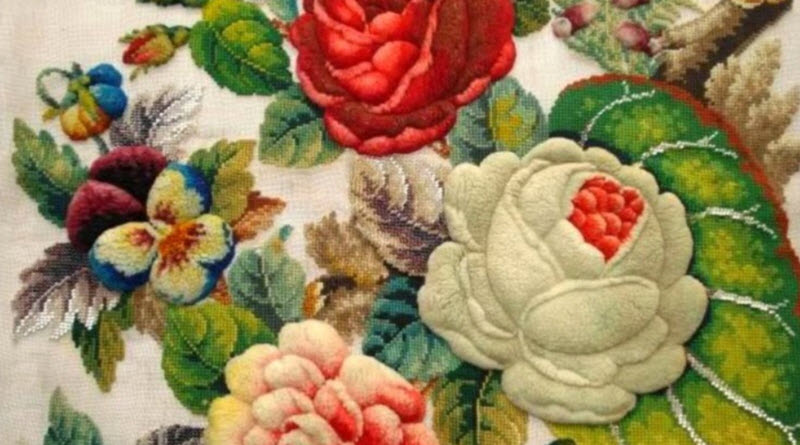Contents

The first patterns for this type of wool embroidery were issued in Berlin, hence the name Berlin wool work. From Germany, the patterns spread to the United Kingdom, and from there to Canada and the United States.
Berlin wool work (BWW) is done with wool yarn on a canvas. Preserved works from the 19th century, they heyday of BWW, have often been made using a multitude of colors, and elaborate shading has been employed to achieve seemingly three-dimensional effects. In those days, BWW was commonly used to adorn items that had to withstand plenty of wear and tear, such as purses and upholstered armchairs. The embroideries were normally done single-stitch style, e.g. with tent stitches or cross stitches, but not always. The famous “Beeton’s book of Needlework”, published in 1870, lists no less than 15 different stitches for Berlin wool work.
The imagery of 19th century Berlin wool work patterns are often religious or depicts either nature (especially flowers) or idyllic domestic bliss. They were influenced by the prevailing ideals of the Romantic era, an artistic movement in Europe that reached its peak in 1800-1850. Short inspirational quotes were very popular, such as “Home Sweet Home” or “Faith – Hope – Love”. It was also possible to purchase patterns that were reproductions of famous contemporary paintings.
Several notable 21st century Berlin wool work embroideries have been created by artists who juxtapose these seemingly idyllic scenes with contemporary themes of a harsher nature.
Berlin wool work – a 19th century favorite
The first patterns for Berlin wool work were published in Berlin in the early part of the 1800s. They were printed with black ink on a grid paper, and then colored by hand. You didn’t have to buy a whole booklet: you could buy just a single sheet, which put these pattern within the reach for many, even people with rather moderate means. The Berlin wool work patterns quickly became a big hit that spread throughout Europe and North America, partly thanks to women’s magazines such as The Englishwoman’s Domestic Magazine.
As mentioned above, the patterns were hand-painted before reaching the consumer, and the colors suggested were often bright and full of richness. Several notable improvements regarding yarn dyeing had been achieved in the 1830s, and many beautifully colored yarns were now available at a lower price than before.

The Great Exhibition of 1851
In 1851, The Great Exhibition of the Works of Industry of All Nations took place in London, and one of the things exhibited were the Berlin wool work patterns. This further helped boost their popularity far and wide.
Decline
During the penultimate decade of the 19th century, new styles of embroidery became trendy and fewer people did BWW. One reason for its decline in popularity was that while mainstream tastes had changed since the patterns were first launched, the producers were reluctant to accommodate for this. They kept churning out patterns in the old style, and failed to make adjustments for new market demands.
Also, the Arts and Crafts movement had gained momentum – both back home in Britain and in other parts of Europe, as well as in Canada and the United States – and this movement championed other ideals for all sorts of decorative art, including needlework art.
